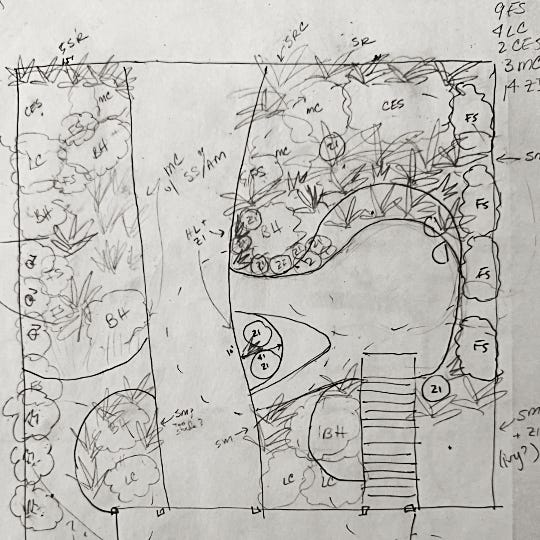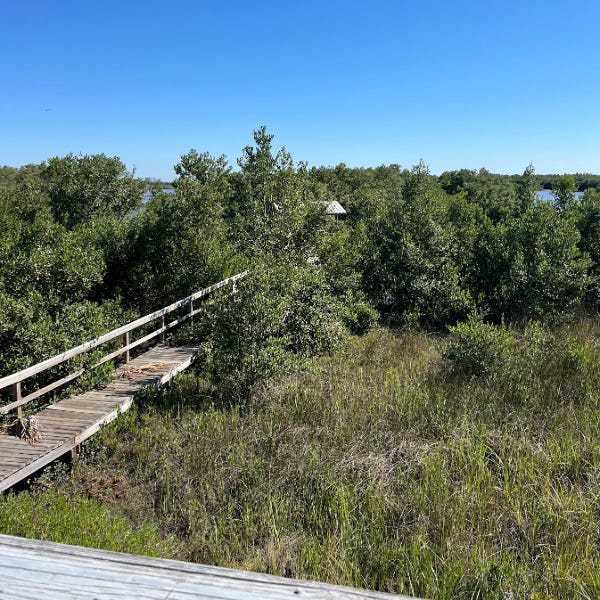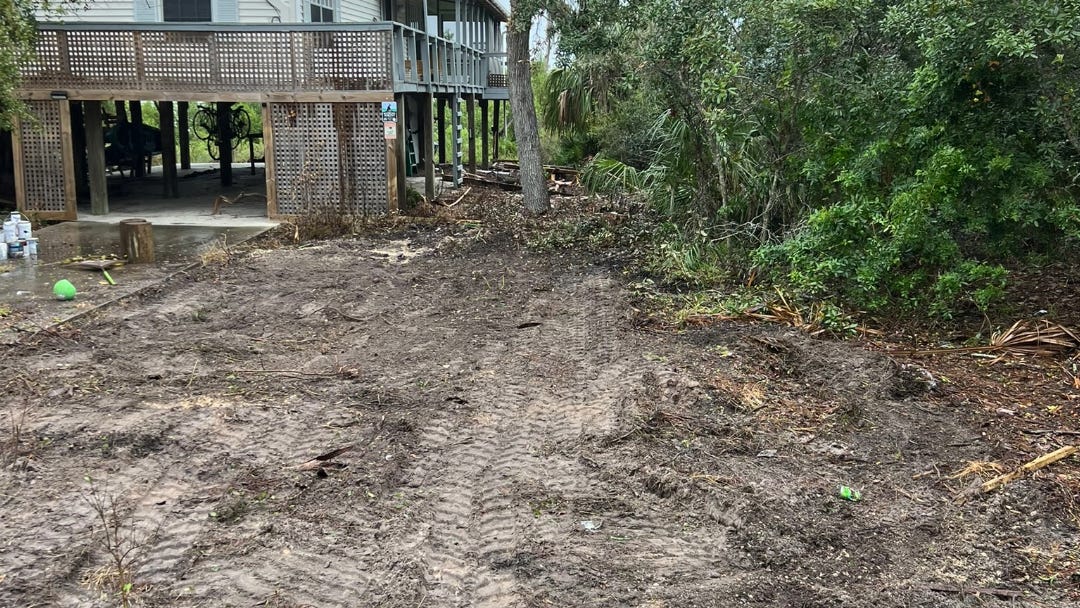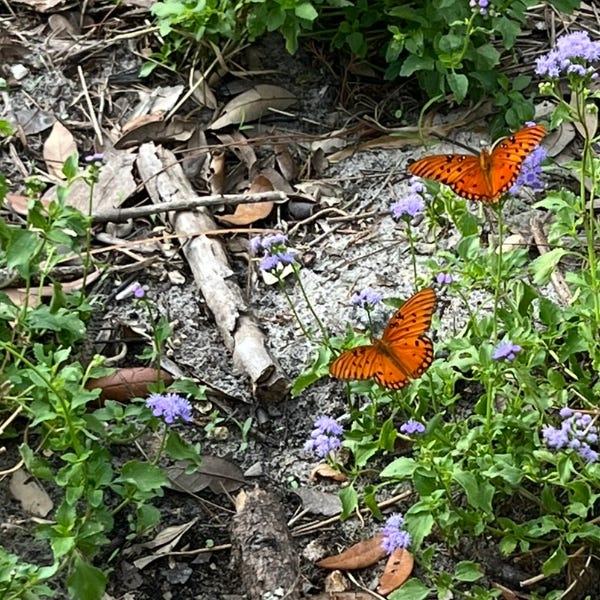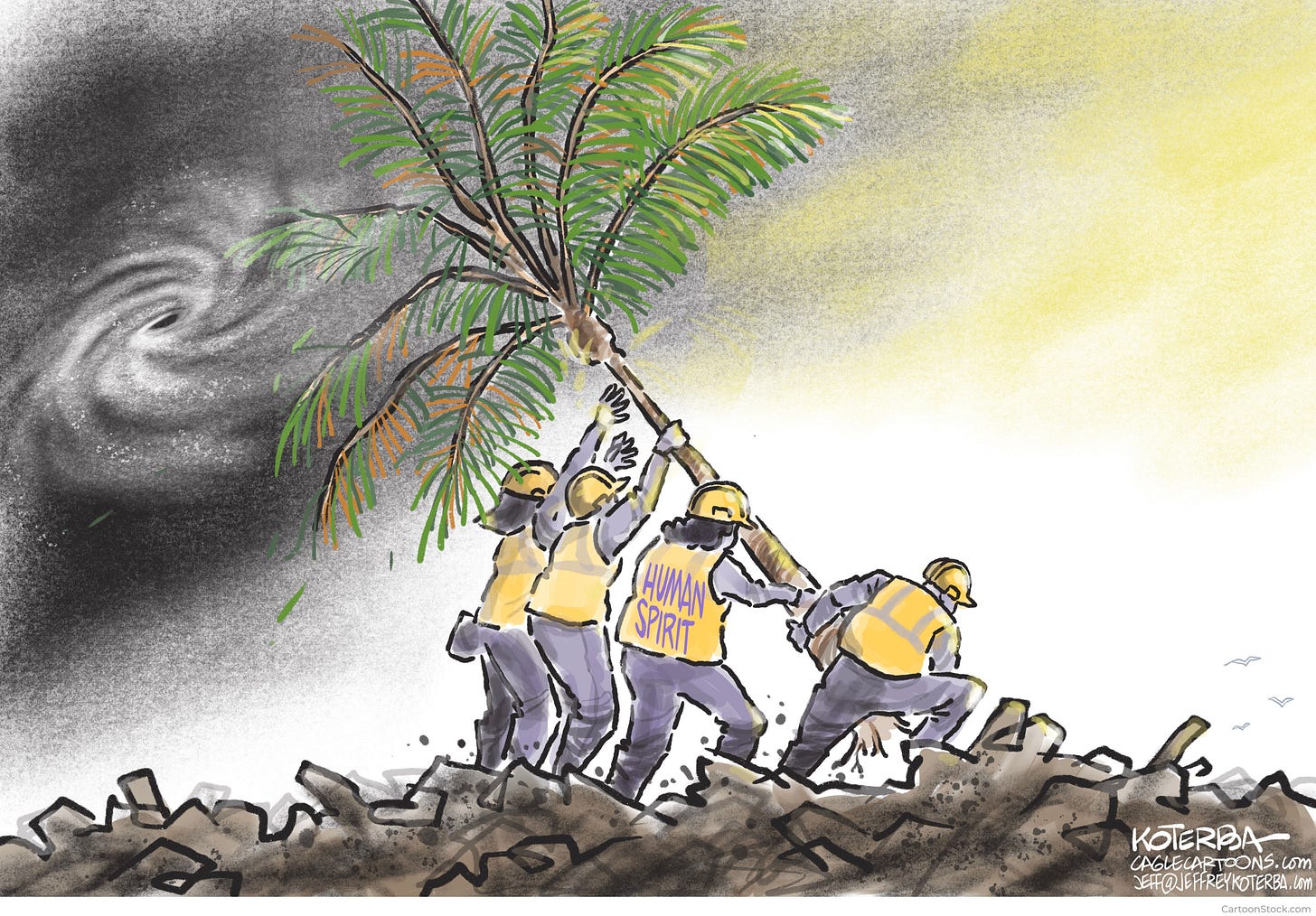2 Weeks from Devastation to Delight
How my daughter Zoe and her native gardening skills came to my rescue
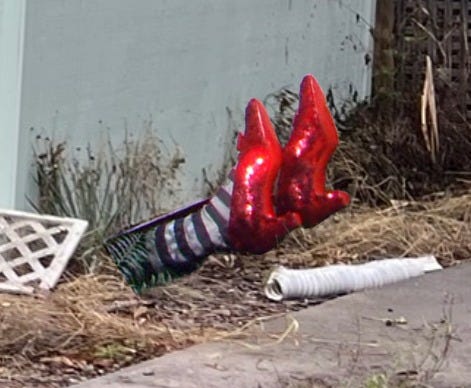
Dear Yardener,
Design Your Wild remains mostly an advice column. Please send your questions in the comments below or by replying to this email. Your challenges inspire me! Today, however, I’m going to share my own case study, which starts in a grim place.
But first, apologies to those — hundreds? thousands? — who tried and were unable to upgrade to a paid subscription last time. I forgot to restart payments on Substack. Please consider upgrading now. For $30 per year, you will receive early notice and free admission to two live, virtual workshops, including our first, Quick and Easy Yard Layouts, on February 11 from 5:30 to 7 p.m. Eastern Time.
Devastation on the Gulf coast
Hurricane Helene threw 12 feet of Gulf seawater over our Florida town, punching through cinder block walls and sweeping whole houses into the sea. As many as a quarter of the homes here may have been destroyed by Helene, the third hurricane to hit the area in just over a year. (Curious why? See below.)
Pete and I were lucky. Our house is located on a bayou of mangrove islets and raised on stilts. Only about five feet of water washed over our lot and under our house. It arrived not from our waterfront, but from the opposite, more open side of the island. It gathered leaves, lumber, a gas tank, numerous plastic containers, and an entire shed and deposited them in our yard. It destroyed our HVAC system, hot water heater, the electric outlets under the house, and the tools and bikes in our shed.
That’s a lot of damage, sure, but nothing compared to what many others suffered. We are now living comfortably, debris removed and systems and tools replaced. Our neighbors across the street, whose houses are not raised, are still living in RVs or borrowed homes while contractors replace their floors, dry wall, appliances, and cabinets. Elsewhere, debris-filled lots, with and without dilapidated houses, await permissions or insurance money or a buyer, the current owners having thrown in the towel.
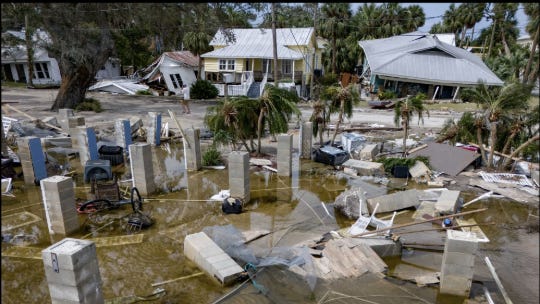
My pathetic yard
It’s small potatoes in comparison, but do you know what discouraged me the most about our own situation? Our front yard, which Pete and I have spent four years planting and tending, was reduced to a sandlot. The entire south side of the front yard was empty, all the plants removed by heavy equipment brought in to dismantle and haul off the shed.
I know, I know, it seems petty to worry about some plants with such ruin all around. But having had a horrible year personally made it more difficult to contemplate starting my garden over from scratch. I felt overwhelmed. I did not have the energy to even think about what to do next.
Zoe to the rescue: Transforming a yard in two weeks
My solution was to ask my daughter and Design Your Wild partner Zoe to transform our yard — ASAP. She had attacked her own current yard with admirable gusto and impressive results, ordering and installing thousands of plants and transforming half an acre much faster than the typical three to five years for a native yard.
Well, Zoe outdid herself in my Florida yard. She transformed it from sandlot to wildlife haven in two weeks. Here’s how:
1. Start with an overall layout.
Luckily, the circular gravel “patio” and arcing gravel paths I had created remained after the hurricanes, buried under a thick bed of debris and leaves. And I was able to share a scale drawing of the overall layout I created several years ago. This layout (often called a master plan) reflects the existing conditions (the location of the house, driveway, existing trees), plus the major structural elements of planned changes — like paths, seating areas, and structural plantings.
Zoe and I quickly agreed the new layout would require lots more woody plants than my original plan. We hoped the new shrubs and small trees, once established, would act as a sieve to keep debris and errant sheds from washing into our yard, much as the rim of mangroves protected the Gulf side of the property. Without deciding on species, we imagined tall shrubs covering more than half the yard — several deep along the road, filling in along the two side lot lines, obscuring the area under the stairs.
2. Identify “right plant, right place.”
Not wanting to replant yet again, I asked Zoe to limit the plant palette to the relatively small group of plants that evolved on Florida dunes, where they grow in sand and tolerate long periods of dryness and occasional saltwater inundations. In contrast, my initial plant selection, which did not anticipate saltwater inundation on the road side of our house, included many plants that evolved in upland hammocks and did not not survive the surge.
Regular readers know by now to bypass big box stores and even large local nurseries when looking for native plants. Unfortunately, the native nurseries closest to me specialize in upland plants, not coastal ones. I recommended that Zoe work with Wilcox Nursery near Tampa, more than two hours away; they have an entire webpage devoted to salt tolerant Florida native plants.
Zoe knew that to achieve instant transformation we needed to select from what Wilcox had available. Moreover, we wanted the largest, most mature plants of each species so their large root balls would anchor them in case of another inundation within a year. Plus, we wanted them to look good quickly, not wait years for slow-growing palms to reach their mature sizes.
To help arrange specific plants in the overall layout, Zoe prepared a “planning to plant” spreadsheet. She’s amazing at this sort of organization and included extensive detail about each species, plus links to both the Wilcox and Florida Native Plant Society description of each species. Only species suited to our soil, moisture, and coastal conditions made the list, so the most important data for planning and ordering were sunlight requirements, mature sizes, and the number of each size currently available.
3. Install lots and lots of each species.
Using her spreadsheet, Zoe sketched the locations of various plants onto my original plan. This allowed me to envision her planting plan and her to estimate the number of each species required; the final plant placement would be worked out on the ground. For example, Zoe showed silver buttonwoods interspersed with olive-green wax myrtles along the road to form the vanguard of our living sieve, look impressive from the road, and create privacy within the yard. She also created structure by rimming the gravel paths with coonties, cycads that are now threatened in the wild. And she added color by massing pink muhly grass on either side of the driveway.
The rough sketch was enough for me to fall in love. I was so enamored of Zoe’s arrangement of coonties along the paths, I suggested extending them around the entire patio. With this feedback, Zoe adjusted the sketch, then prepared her order for the nursery: 147 plants from 17 species, ranging from three of the seven-foot tall buttonwoods to 24 coonties.
4. Play with placement, then install.
Zoe flew down from New York to locate and install the plants. The day she arrived, she placed them, still in pots, where we would plant them. It’s an artistic endeavor, like daubing paint on a canvas. She stands back, reflects, moves a pot a few inches. Reflects some more. After she finished, I made a few suggestions, some of which she took.
The second day, Zoe, Pete, and I planted and planted and planted. After a day of rest touring the Lower Suwannee National Wildlife Refuge, we planted what was left. I moved live oak leaves from the storm debris around the new plants as a natural mulch to slow evaporation and add some organic material. All done.
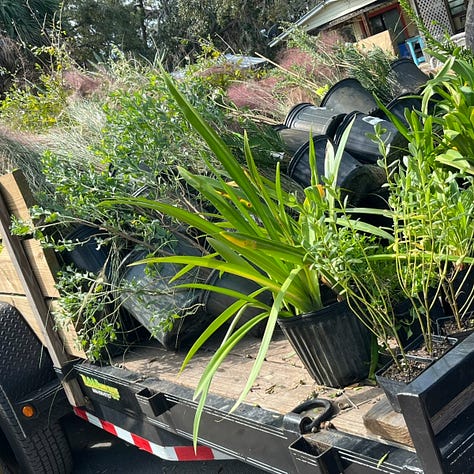
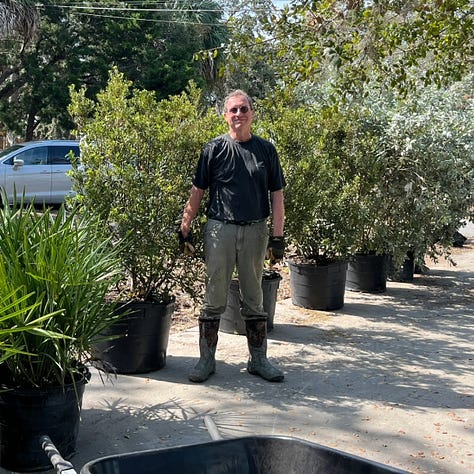
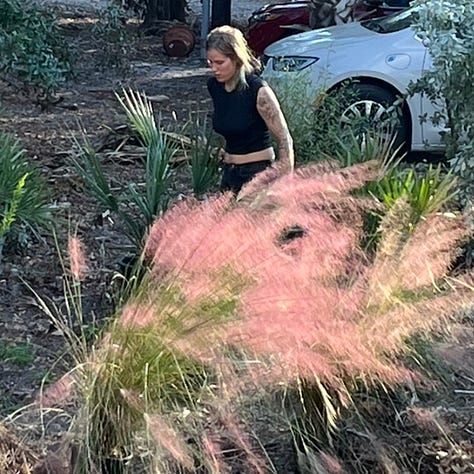
5. Water, water, water.
I tend to be Darwinian in my attitude toward native plants, erring on the side of doing nothing. And this works pretty well except when it comes to watering. Not giving plants enough water after transplanting will kill them. Been there. So this time, I delegated watering to someone who understands its importance — my husband Pete.
Pete installed two lawn sprinklers on light-activated timers to water each morning, placing reused plastic containers as rain gauges. Initially, he set the timers to run long enough to give an inch of water daily. After two weeks, he reduced the amount, tapering to an inch twice a week for two months. During this time, it only rained once; if we had received more rain, he would have adjusted the watering schedule. Now, three months later, we water when there is less than one inch of rain per week.
After we were finished, Zoe asked what Yardenality I would consider the yard. Even though the new garden is shrub-dominated, the front-and-center muhly grasses and the contrast of the wild plantings with the clean circles and arcs of the hardscaping and mid-century architecture makes it Prairie Modern to me. Take a look at the before and after shots below and let me know what you think.
— Heather
Why, How, Wow!
Why?
A confluence of factors contributed to the record-breaking surge from Helene in the Big Bend of Florida. First, sea levels in the Southeast are rising faster than elsewhere in the country — even faster than projected.
And the deluge stretches all across the South and the Gulf Coast; over the past 14 years, sea levels in the U.S. South have risen twice as fast as the global average. …
Many people think of the ocean like a bathtub — turn on the faucet, and water levels rise everywhere. As the planet warms and ice melts, they assume that the ocean might act in the same way.
Sea level rise, however, is very uneven. Thanks to a complex set of factors, water levels are not rising at the same speed everywhere. And these factors have made the U.S. South particularly vulnerable. — The Drowning South: Why seas are surging, The Washington Post
It turns out, melting ice decreases the gravitational pull of the polar ice caps on the ocean, increasing sea levels more further from the ice caps.
Normally, that enormous weight pulls oceans close to the ice sheets, making sea levels around Greenland and Antarctica higher than they would be otherwise. But as the ice melts, that effect lessens. Sea levels close to the ice sheet fall, and sea levels farther away rise. — The Washington Post
Sinking land is also contributing to sea rise in the South. But the largest impact is from increasing ocean temperatures. The shallow continental shelf that extends 150 miles into the Gulf exacerbates impact.
In general, the effect of temperature on sea level rise is simple: added heat expands ocean waters. Deep ocean waters play a particular role — as they expand, they cause sea levels to rise out in the open ocean. That expanded water then surges onto the coasts, spiking sea levels along beaches and shorelines. – The Washington Post
Warmer Gulf waters also increase the strength of hurricanes like Helene, which gather strength as they move over warm water. And Helene’s eastern side, which typically has the strongest winds, hit the Big Bend. In addition, the shape of the Gulf acts as a funnel, pushing water into the Big Bend.
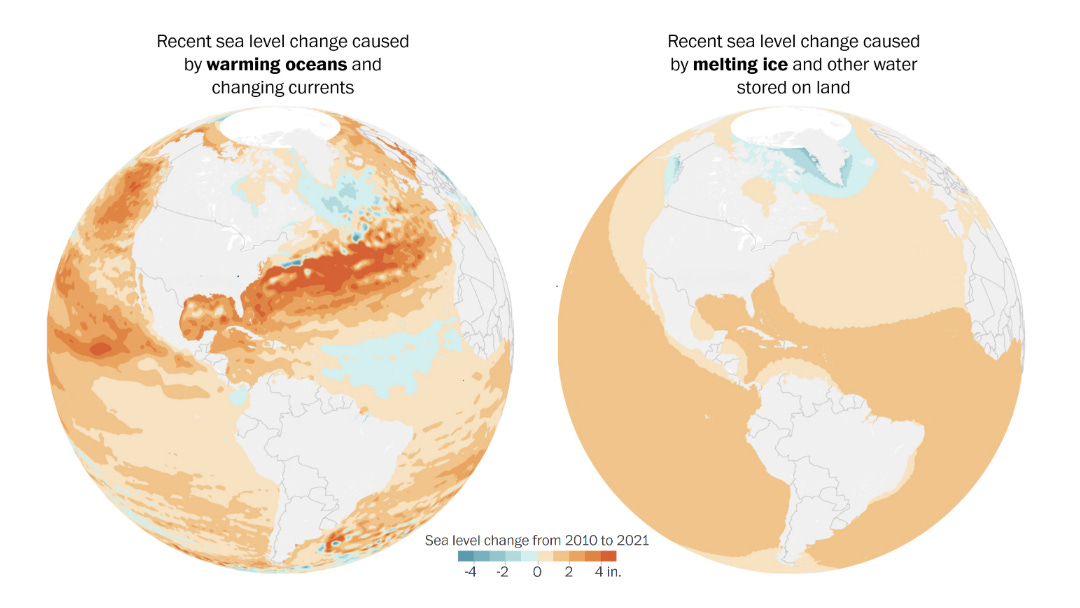
How
Or really, how much? Americans aren’t used to spending a lot on plants. Lawn, which dominates most yards, is inexpensive to install. However, it’s expensive to maintain, as well as costly for the environment. In contrast, the cost of maintaining my all-native yard should be minimal. We spend nothing to maintain the established native plantings on the Gulf side of our property — and it stays gorgeous right through the surges.
We spent about $7,000 on plants to transform about 1,200 square feet of yard. Does that seem high to you? It’s high relative to the expectations I hear from students and friends, but much less than professional landscaping. Based on studies of the impact of landscaping on real estate values (link below), I’m confident we’ll recoup several times the investment — in addition to the joy we derive from it in the meantime.
Wow!
Birds and butterflies returned to our yard almost as soon as we installed the new plants. It will all look even better when the plants spread out as they grow. In the meantime, I already smile each time I see them from our windows or as I descend the stairs to the yard.
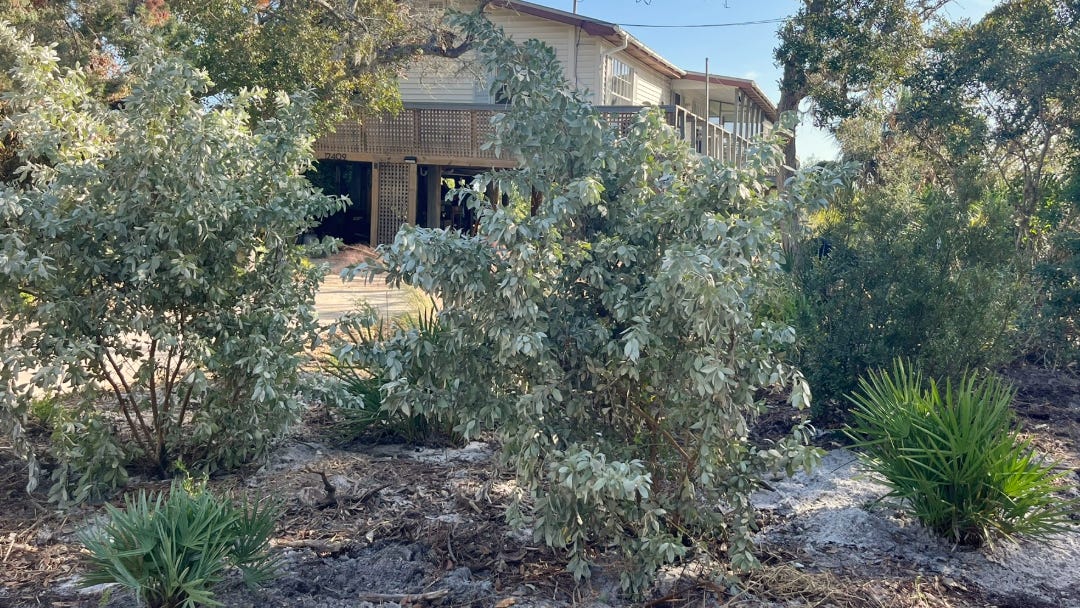
My favorite plants are the silver buttonwood along the road and the beach mistflower along the paths near the house. The mistflowers are an endangered, short-lived perennial native to the Florida Keys, south of here. They are constantly covered in butterflies.
Related Resources
3 Steps to a Master Plan for Your Property If you’re ready to create a master plan, become a paid subscriber now to join our live, virtual workshop, Quick and Easy Yard Layouts, on February 11 from 5:30 to 7 p.m. Eastern Time.
Wilcox Nursery’s salt-inundation tolerant central Florida native plants
Salt tolerant native plants (east of the Rockies; great for along salted streets in snowy areas, as well as on the coast)
Zoe’s planning to plant worksheet – blank template and Florida native plants




